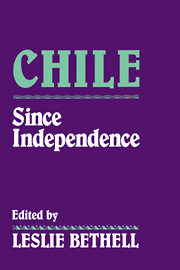2 - From the War of the Pacific to 1930
Published online by Cambridge University Press: 05 June 2012
Summary
As Chile entered the 1870s the Republic could look back on 40 years of virtually uninterrupted constitutional stability – unique in Spanish America – and the evolution of a functioning multi-party system in politics. She could also look back on the growth of a modest but promising economy, based on the export of primary products from land and mine. Her population had doubled since Independence, from one to two million by 1875; her foreign trade, dominated from 1830 to 1870 by copper exports, had grown apace, providing adequate revenue for successive governments to initiate transport improvements, notably railways, develop educational programmes, provide urban amenities – and preserve law and order. In foreign affairs, Chile had not only maintained her independence but in the 1830s had also prevented the combined attempt of Peru and Bolivia to assert hegemony on the Pacific coast of South America.
The country's capacity to attain these objectives undoubtedly owed a good deal to the constitutional system created by Diego Portales (1793–1837), backed by a remarkably homogeneous landed aristocracy and based upon the authoritarian, centralizing constitution of 1833. That constitution, coldly realistic, recognized what Chile was rather than what it might aspire to be: it appreciated what Portales called ‘the weight of the night’, the sheer traditionalism of three hundred years of colonial control, during which the basic lineaments of society had been drawn, and accepted that independence from Spain was indeed a fundamental political act, but had virtually no economic or social content.
- Type
- Chapter
- Information
- Chile since Independence , pp. 33 - 86Publisher: Cambridge University PressPrint publication year: 1993
- 7
- Cited by



